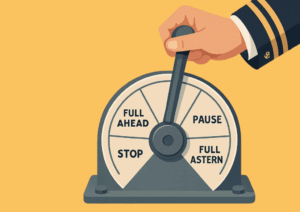Writing a project brief is a crucial step in ensuring the success of any project. It serves as a foundational document that outlines the project’s objectives, scope, and key details. A well-crafted project brief helps align expectations, facilitates communication between stakeholders, and provides a reference throughout the project lifecycle.
When talking to potential clients, we encounter the following common issues:
- Unclear or endless lists of features
- Misunderstanding user needs
- Lack of iterative development knowledge
- Poor communication of context
- Unclear go-to-market strategies
- No unique value proposition
To make sure we’re all on the same page, let’s look at how to create an effective project brief, avoid these pitfalls, and make sure your project starts on the right foot.
At a Glance

When Do You Need a Project Brief?
Formulating your thoughts will help you make sure you haven’t missed anything important. It will help you approach vendors for their quotations, help vendors with their analysis, and shorten the time between your request and their offer submission. Moreover, a project brief ensures alignment of expectations among stakeholders, preventing misunderstandings and scope creep.
“Can’t I Simply Tell You What I Need?”
When you have your high-level project details in writing, you can always revise them. It also saves you time when approaching multiple vendors — rather than re-telling the same “story” over and over, you provide everyone with identical starting information. Additionally, a documented brief allows for iterative consultations and revisions, enhancing clarity and precision over time.
A project brief serves as the definitive reference point or “point of truth” when sharing information with multiple stakeholders such as project managers, developers, and designers. It ensures everyone is aligned with the project’s objectives, scope, and key details. This central document helps maintain consistency and clarity, preventing misunderstandings and ensuring all team members are on the same page throughout the project lifecycle. By using a project brief, you facilitate effective communication and collaboration, leading to a smoother project execution at later stages.
Brief or Requirements Specification?
A brief is a high-level description of a project. It often contains information about the problem, intended solution, and target user base. It may specify some technical details (such as the intended hosting provider, the preferred technology stack, and so on). A brief may contain high-level requirements, giving a rough idea of the type of solution required (do you intend to build a “scooter”, a “bike”, or a “sports car”?). For example, high-level requirements might include functionality such as user authentication, whereas detailed specifications would delve into the specific technologies and methods used for implementing this feature.
How Brief Could the Brief Be?
Now, that’s a tough question. On the one hand, the more details you provide, the more accurate efforts (read “budget”) estimation you’ll receive. On the other hand, you can hardly call an 80-page document a “brief”. It takes a lot of time to prepare one, as it does to analyse one. There are cases when it’s okay to have such a detailed brief — when you have a lot of flows to visualise or algorithms to explain. Striking a balance between detail and brevity is crucial; focus on essential information that aids in understanding the project without overwhelming the reader.
Should It Be Technical?
This partly depends on your technical background. If you are a technical specialist looking for someone who can bring your idea to life, you can be as technical as you want. An important thing to consider, though, is that sometimes your view may be limited by technologies you are familiar with. An external provider may offer you options you hadn’t considered or even known about.
If you are not a technical expert, leave this part to your vendor. Focus on explaining the business side of the project; it’s where you are the expert, and no vendor can match you. They will provide you with their technical expertise, and you will guide them through the domain and specifics of your business.
By collaborating with technical experts (if available), you can create a well-rounded brief that covers all necessary aspects.
Is There Any Difference If the Solution Is Intended For Internal or External Users?
The key difference lies in how you should view this solution and where your focus should be.
An internal project is intended to be used within your company or by one of its divisions. While catering to all stakeholders’ expectations is essential, you already have a loyal user base.
These projects usually address existing issues, so your users likely have been awaiting this solution. They can be more forgiving of product issues or release delays.
You likely have the necessary funds allocated for this project, which is considered an expense for the company.
Your key focus should be on the business aspects and how the solution fits within your organisation’s ecosystem and infrastructure.
An external project is something you offer to the market. In the case of a B2B or B2C product, you step into a competitive market environment with its established norms and expectations. You create a product based on your assessment and assumptions, but the reality can differ. You may think you’ve identified an important problem and that users will pay for your solution, but they may not agree with you or like your approach.
Budget is a major constraint, and you must prioritise features to address the most critical problems of your audience while minimising costs.
Your key focus should be on market validation, early release, and gathering feedback.
So, depending on your project type, make sure your brief has the right vantage point.
How To Make a Good Brief
Creating a well-structured project brief is essential for the success of any project. Here are the key components to include:
1. Provide Context
Clearly state the problem your project aims to solve. Explain why this problem exists and what its impact is. Identify the intended audience and why this solution is important to them.
2. Describe the Ideal Solution
Outline the envisioned solution in one or a few paragraphs. Focus on what the solution will achieve and how it will address the problem. This should provide a clear picture of the project’s goals and deliverables.
3. List the Main Actors and Their Motivation
Identify the key stakeholders and users of the solution. Describe their roles, needs, and how they will interact with the solution. Understanding their motivations helps in designing a user-centred project.
4. List the Main Features of the Solution
Detail the primary features of the solution, focusing on the business perspective of what, why, and how. Avoid spending too much time on minor details like table layouts or button designs unless they are crucial to the project’s success.
5. Specify the Expected Timeline
Provide a realistic timeline for the project, including the expected start and end dates. Highlight any important milestones and deadlines critical to the project’s progress.
6. Be Realistic
Adopt an iterative development approach. Start with a Minimum Viable Product (MVP) to validate the concept, then move to a Minimum Marketable Product (MMP), and continue to develop and refine the solution based on feedback and market needs.
7. Include Risk Management and Contingency Plans
Identify potential risks that could impact the project and outline strategies for mitigating these risks in the simplest possible form.
Incorporating these elements will make your project brief comprehensive, ensuring clear communication and alignment among all stakeholders.
Project Brief Checklist
Use this checklist to ensure all critical aspects of your project brief are covered:
Context
☐ Clearly state the problem your project aims to solve.
☐ Explain why this problem exists and what its impact is.
☐ Identify the intended audience.
Ideal Solution
☐ Describe the envisioned solution in one or a few paragraphs.
☐ Focus on what the solution will achieve and how it addresses the problem.
Main Actors and Motivation
☐ Identify key stakeholders and users of the solution.
☐ Describe their roles, needs, and motivations.
Main Features
☐ List the primary features of the solution.
☐ Focus on the business perspective of what, why, and how.
Timeline
☐ Provide a realistic timeline, including start and end dates.
☐ Highlight important milestones and deadlines.
Iterative Development
☐ Consider an iterative development approach.
☐ Outline plans for MVP and MMP stages.
Risk Management and Contingency Plans
☐ Identify potential risks and mitigation strategies.
☐ Include contingency plans for unforeseen issues.



